German overwhelming Japanese world passenger car engine pattern changes
Before editing: Not long ago, this newspaper published the results of the 2009 International Engine Awards. Engines of brands such as Volkswagen, Mercedes-Benz and BMW have performed well in multiple selection projects. The selection is organized by the British Engine Technical Journal "International Engine Technology" and has been held annually since 1999. This edition reviews and compares the results of previous selections to show readers the changes in the technical characteristics and comprehensive performance of engines produced by automobile manufacturers in different countries.
German engine leading
The results of this year's International Engine Awards show that the German engine has won 11 of the 12 awards, of which the four brands of Volkswagen, Mercedes-Benz, BMW and Porsche are the main winners. The German engine has already occupied a clear dominant position.
The leading position of German engines in the field of international passenger car engines has been gradually established in recent years. 2002, 2003 and 2004 were three years of mediocre German engine performance. In 2002 and 2003, the German engine won 5 awards. In 2004, it only won 4 awards, reaching the lowest level in history. Since 2005, German companies have begun to exert their strength, and the number of winning projects has gradually increased. By 2007 and 2008, the number of awards won has reached 10. This year, with 11 awards received, the performance of the German engine has reached the best level in history.
The success of the German engine depends on its outstanding performance. The characteristics of the German engine can be summarized in the following three aspects: First, the engine is highly dynamic. The German engine attaches great importance to the improvement of power performance, and has many turbochargers. For example, the BMW 3.0L twin-turbocharged engine that won the Best Engine Award in the 2.5-liter to 3-liter (inclusive) category uses twin-turbocharger technology. Relevant data shows that the twin-turbocharger technology can enable the engine to achieve greater power with a small displacement, and can generally compete with engines with a displacement of 0.6L to 0.8L larger than their own.
Secondly, German automakers have invested heavily in diesel engine R & D, and it currently seems to have achieved good returns. In Europe, the market share of diesel vehicles is as high as 47%. Various encouraging tax policies and consumers ’general acceptance of diesel engines have greatly promoted the development of diesel engine technology. This has made European manufacturers spare no effort to invest in In the development of new diesel engines. Therefore, in terms of diesel engine technology, European car manufacturers are ahead. The previous award-winning diesel engines are all German products, such as the Mercedes-Benz 2.1L CDI diesel engine that won the best engine in the 2.0L ~ 2.5L (inclusive) group in 2009, and the best 2.5L ~ 3L (inclusive) group in 2007. BMW 3.0L twin turbo diesel engine with a good engine.
Third, pay attention to improving fuel economy. The German engine has always given the impression that it puts too much emphasis on power performance rather than fuel economy. However, this situation has changed. In the 1990s, due to the strong impact of Japanese engines with better fuel economy, German companies took various measures to improve fuel economy. For example, German Volkswagen launched an engine using FSI fuel stratified injection technology in 2001, which accurately injects fuel into the combustion chamber at a higher pressure. Compared with traditional engine technology, the power of the FSI engine can be increased by more than 10%, while the fuel consumption is reduced by 10%.
German engines are actively exploring fuel-saving technologies while giving full play to their power advantages. At present, the investment in German engine development is still maintained at a relatively high level, and it may still have very good performance in the future.
Japanese engines lose their former glory
In 2009, Japanese engines received only 1 of 12 awards. Judging from the awards in previous selections, Japanese car engines have lost their former glory, and their overall performance has been declining in recent years.
In 2002, Japanese engines won five awards. Among them, Honda has four items alone. In 2003, Japanese engines won 7 awards. This year, Mazda's rotary engines were sought after by the industry. In 2004, the award-winning projects of Japanese engines continued to increase, reaching eight. Toyota Prius 1.5L hybrid engine replaced Mazda's rotary engine and became the biggest winner of the year. This engine has won four awards and belongs to "there is no one before, no one after".
In 2005, Japanese engines began to decline from their peak. After 2005, Mazda ’s engine failed to win the prize. In 2007, Honda ’s engine also began to miss the award. Only the Toyota family relied on the Prius 1.5L hybrid engine and 1.0L inline three-cylinder VVT-i engine to appear in the selection. However, in 2009, the Toyota Prius engine finally lost its interest to the judges due to the age. Only the Toyota 1.0L in-line three-cylinder VVT-i engine, which is not distinctive in its features, remains a bit of the light of the Japanese engine.
funcTIon ImgZoom (Id) // Re-set the image size to prevent the form from being broken {var w = $ (Id) .width; var m = 650; if (w <m) {return;} else {var h = $ (Id) .height; $ (Id) .height = parseInt (h * m / w); $ (Id) .width = m;}} window.onload = funcTIon () {var Imgs = $ ("content"). getElementsByTagName ( "img"); var i = 0; for (; i
Antenk DIN41612 Connectors are a versatile two piece Pcb Connector set with feaures useful for many applications including connections for plug-in card and back-panel wiring, PCB to PCB attachment and peripheral connections for external interfaces. Features include a multitude of body sizes and styles with options that include selective contact loading, make and break contacts, contact lead length choices and contact plating variations each in .100" [2.54mm] or .200" [5.08mm] centerline spacing.
The Din 41612 standard covers a series of two-piece backplane connectors widely used in rack-based telecommunication, computing, process control, medical, industrial automation, test and measurement and military/aerospace systems where long-term reliability is required. They consist of one to three rows of contacts in combinations of 16, 32, 48, 64, or 96 contacts on a 0.1-inch (2.54 mm) grid pitch. The 3 rows are labelled a, b and c and connectors up to 64 way if using a 96 way body can use either rows a+b or a+c. DIN 41612 Signal connectors can be rated to 1.5 amps per signal pin, at 500 volts, although these figures may be de-rated according to safety requirements or environmental conditions. Several hybrid power and coaxial configurations are available that can handle up to 5.6A or even 15A. This wealth of variations explains the very wide range of applications that they`re put to. For over 30 years these DIN 41612 `Euro Card` connectors to IEC 60603-2 have offered a highly reliable system for board interconnects. Precision contact density, low mating forces, a two piece protective design and many contact termination styles offer unlimited design opportunities. Termination methods include – straight PC, solder eyelet, wire wrap, crimp and [press fit" terminals. Insertion and removal force are controlled, and three durability grades are available. Standardisation of the connectors is a prerequisite for open systems, where users expect components from different suppliers to operate together; ept and Conec DIN 41612 are therefore fully intermateable with all other similarly compliant products from other manufacturers like Harting, Erni, Hirose and TE Connectivity, etc.
The most common connector in the DIN product line is type C, which is widely used in VMEbus systems, the DIN 41612 standard has been upgraded to meet international standards IEC 60603-2 and EN 60603-2. In the past, ept used a comb supported press-fit tool for their type C and B press-fit female connectors. To be more competitive, ept has changed to flat-rock technology (just a flat piece of steel pushed on the top of the connector) as used by many other manufacturers.
DIN 41612 Connectors are widely used in rack-based electrical systems. The standard performance of these connectors is a 2 A per pin current carrying capacity and 500 V working voltage. Both figures may be variable due to safety and environmental conditions.
Types
Number of contacts varies
Many variations of housing material, including different types of metal and plastic
Both angled and straight versions
Male and female
C,R,B,Q Type DIN41612 Connectors
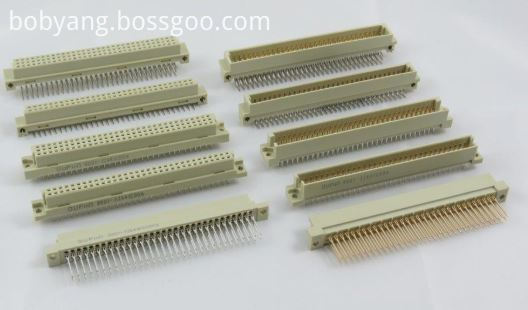
Half C, R, B & Q Type DIN41612 Connectors
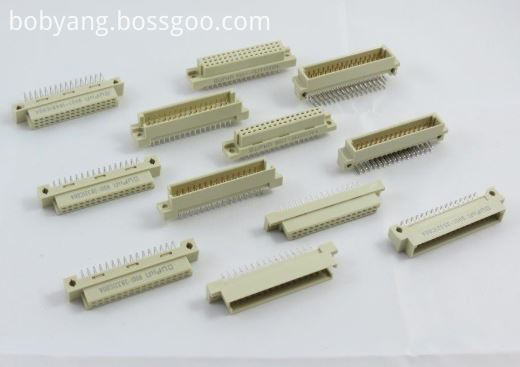
1/3 C,R, B & Q Type DIN41612 Connectors
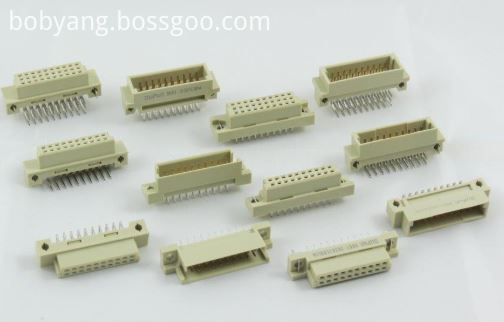
H, F, H+F & M type DIN41612 Connectors
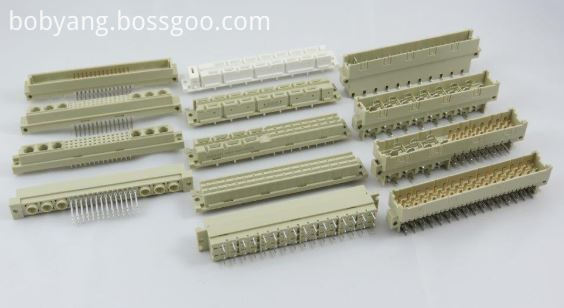
IDC Type DIN41612 Connectors
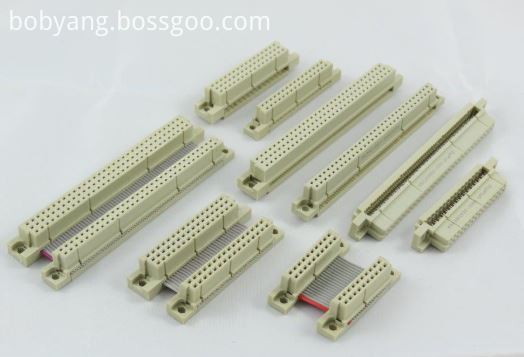
Female Cable Connector
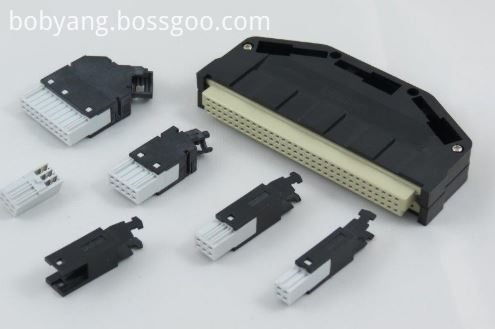
High Pin Count DIN41612 Connectors
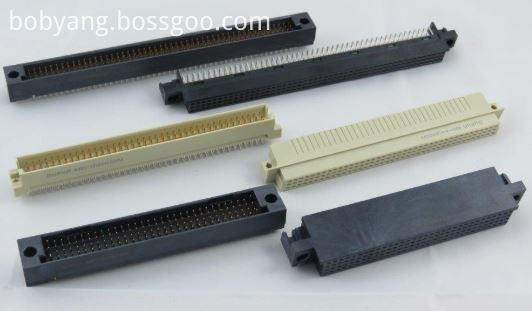
Shroud DIN41612 Connectors
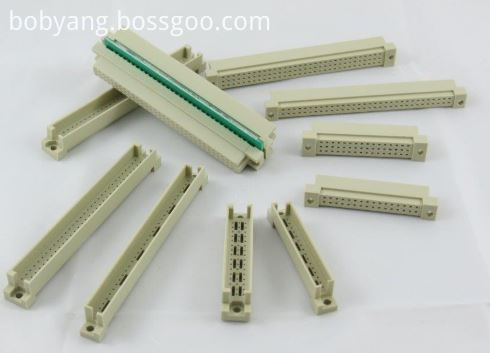
Features and Benefits of Din41612 Connector:
• Indirect mating (male/female)
• Automated production processes
• Continuous quality assurance
• 3-160 contacts
• Complete interconnection system
• Numerous interface connectors
• A wide variety of hoods
• Many termination technologies provide for the lowest installed cost
• Contacts selectively gold-plated
• Tinned terminations for increased solderability
Uses
The primary use of DIN 41612 connectors are PCB connectors and motherboards, the main acceptance would be their board to board reliable connections.
Applications of Din41612 Connector:
Applications
• Data centers
• Storage
• Servers
• Base stations
• Telecommunications equipment
• Backplane and motherboard assemblies
• Switching systems
• Modular rack systems
• Power automation
• Distributed control systems in
industrial control
• Programmable logic controllers (PLC)
• Robotics
• Test and lab equipment
• Energy distribution
• Monitoring equipment
This is not a definitive list of applications for this product. It represents some of the more common uses.
Din41612 Connector
Din41612 Connector,Din 41612,Eurocard Connector Din41612,Male Din41612 Connector
ShenZhen Antenk Electronics Co,Ltd , https://www.antenk.com